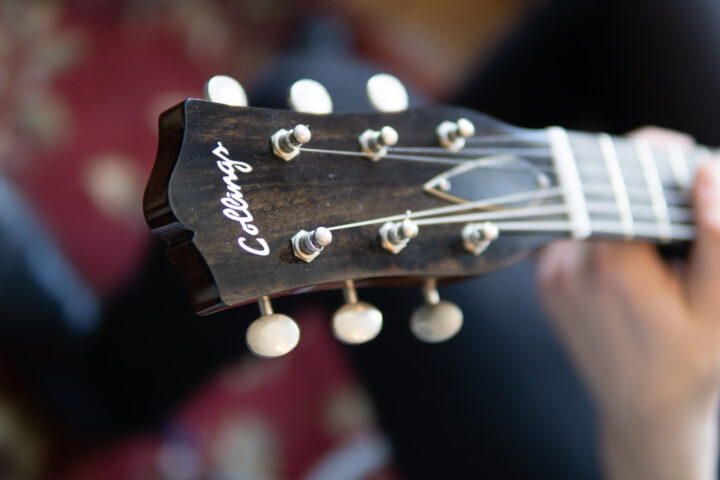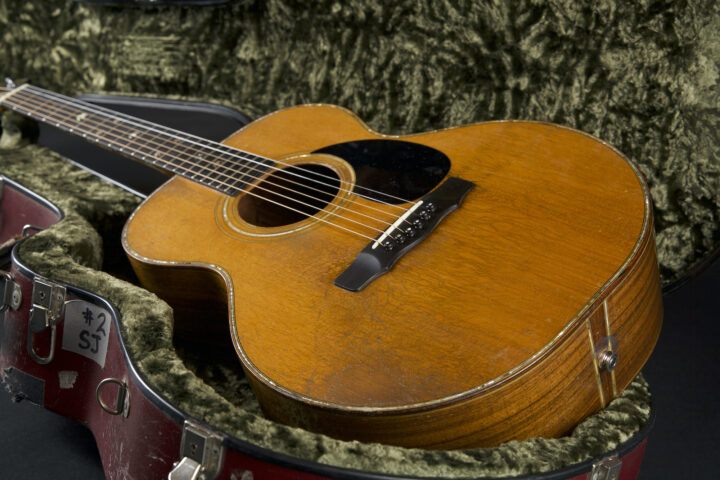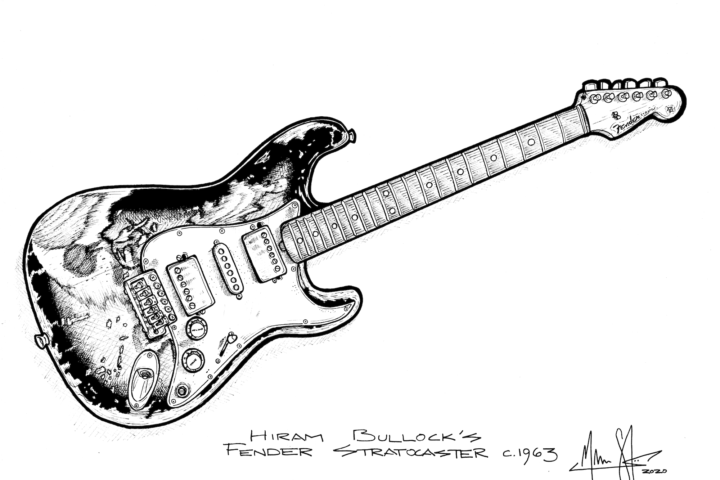In the 1976 documentary Heartworn Highways, Guy Clark is seen fixing a friend’s guitar in his workshop, explaining the appeal of working on instruments. “When you come to the subtleties of ‘em, you can’t really count on any kind of mathematics,” he says. “You can count on mathematics as far as the scale is concerned, but once it gets down to making ‘em play right, every one’s different … really unique things. So you wind up treating every one different, and then working on ‘em, you don’t get bored.”
Thirty years after the release of that film (which also features Townes Van Zandt, Rodney Crowell and a baby-faced Steve Earle), Clark is spending a spring afternoon in a similar workshop at the home he shares with his wife, Susanna–a painter and songwriter herself. The singer-songwriter is quick to point out a detail from the film that less observant eyes might have missed. “Remember that section where I’m working on the guitar?” he asks. “Doing all this intonation and talking all this shit, just drinking wine. If you look, I was so fucked up I strung the guitar upside down, with the bass strings on the treble side.” The memory elicits a big laugh.
Though country chart success has been more elusive for him than it’s been for Earle and Crowell, Clark’s status as a songwriting genius is unquestioned among the Nashville cognoscenti. Crowell, Johnny Cash, Waylon Jennings, the Everly Brothers, Vince Gill and Mary Chapin Carpenter are just a few of the artists who have covered his songs. Jerry Jeff Walker’s version of “L.A. Freeway” cracked the country charts in the early ‘70s, and Ricky Skaggs’ commercial breakthrough came with “Heartbroke.” The Highwaymen snagged a Grammy nomination with “Desperados Waiting for a Train.”
Nashville’s a town with more than a few luthiers and full-time repair shops. It somehow seems appropriate that Clark, who crafts traditional music with a poet’s touch, is artistic, patient and utilitarian enough to build his own guitars. As he approaches the age of 65, he’s realizing that the dual pursuits of guitar-making and songwriting are inseparable for him.
The combination workshop/office in his basement has a large framed photo of his late friend, Townes Van Zandt. (Not coincidentally, the photo was taken by the renowned Jim McGuire, Clark’s friend of 30-plus years. McGuire also spends this afternoon in the workshop, snapping shots.) Affixed to the bottom left corner of the picture’s frame is a button that proclaims, “Fuck the real world, I’m an artist.” Magazines and books about lutherie and woodworking sit aside his workbench. Of a book entitled Japanese Woodworking, Clark says, “That’s wonderful. They have pull saws instead of push saws and planes that you pull through instead of push through.”
On another wall is a massive shelf of cassettes, some of which are albums by songwriters he admires and some of which are by Clark’s contemporaries. Many of the guitars Clark’s made, along with a Martin 000-28V (“hot-rodded,” he says, with a Richard McClish pickup system), are scattered throughout. The pungent, familiar smells of sawdust, cigarettes and coffee are present, even as a spring breeze blows through the windows. “The ambience,” he says, of the woodshop, “just smells right to me. It just smells right.”
Lutherie is not a recent avocation for Clark. As a struggling singer-songwriter in Los Angeles–a time in his life memorialized in his song, “L.A. Freeway”–Clark worked alongside the Dopyera brothers in their legendary Dobro factory. “I didn’t know who these guys were,” Clark admits. “These guys had been making guitars since the ‘20s.” With Clark’s penchant for describing larger-than-life characters, it’s no surprise that he found quite a few distinctive personalities in the Dobro factory.
“Rudy [Dopyera] was this crazy, old, wizened little wizard-looking guy who had his own little workshop in a loft, and nobody was allowed to walk in there,” Clark recalls. “This was a big open warehouse in Long Beach, and he was up there pounding out bell brass mandolins and all this handmade crazy shit. There was one guy who worked there who had escaped from Cuba on a boat, and he was the only guy on the boat that lived. And he didn’t speak any English. And there was some weird religious fanatic who fretted all the banjos, and some field hippie smokin’ dope, and me.
“It was a pretty far-out experience. I wouldn’t trade it for anything. I spent all day assembling Dobros or National steel-bodies. I could put together six in a day. I always thought it was kind of like building toasters–such an elitist wooden guitar guy–but, you know, I never actually figured out what made them sound good. I think I built about 500. And I’ve seen a couple of ‘em. I could tell that I did ‘em. Matter of fact, [pedal-steel guitarist] Lloyd Green’s got one.”
His love for craftsmanship even predates his time as a luthier. Echoes of a teenage job showed up later in his song “Boats to Build”:
I’m gonna build me a boat
With these two hands
It’ll be a fair curve
From a noble plan
Let the chips fall where they will
Cause I’ve got boats to build
“[It was] one of the best things that ever happened to me when I was in high school,” he says, of his boatbuilding days. “My summer job was working in a shipyard as a carpenter’s helper on the Gulf Coast, with the last guys that built big wooden work boats. Eighty-foot shrimp boats, everything by eye, square to the world, and just to watch those guys do that, man, it influenced me as much as anything I’ve been through in my life.”
When Clark was younger, the great poets held as much sway as his boatbuilding coworkers later did. On the title track of 1999’s Cold Dog Soup, Clark created a traditional story-song tableau that is as reminiscent of an Edward Hopper painting as it is of, say, Bob Dylan:
William Butler Yeats in jeans
Got up to play guitar and sing
In some joint in Mission Beach last night
At the door sat Tom Waits
In a pork pie hat and silver skates
Jugglin’ three collection plates Jesus Christ
“It was a pre-television generation when I was a kid,” says Clark, “and we would read around the dinner table–poetry. Both my parents appreciated good writing. And we would read out loud at the dinner table. I grew up reading Robert Service, Stephen Vincent Benet. It was just wonderful. So I’ve always been attracted to it. And then when the big folk scare of the early ’60s came along, Bob Dylan’s writing songs; well, fuck, I can write songs. Townes Van Zandt’s written two songs; well, I can do that. You know, it was just the natural place for it to go–especially since I have such an appreciation for it.
“Townes and I, every time we thought we were getting pretty fucking good, used to put on a tape of Dylan Thomas reading his own words,” he remembers. “And it was just like, ‘OK, that’ll get it.’”
What goes through Clark’s mind when he thinks of Van Zandt? “Well, I’m pretty used to it,” he says with a smile. “But I think about him every day, will probably ‘til the day I die. He was my best friend for 35 years. It’s just there. Not gonna dwell on this. No, no, it’s not like that. Mostly I’m still pissed off at him.”
Standing in the midst of Clark’s workshop, you can’t help but notice that the line between Clark the luthier and Clark the songwriter is blurry–or even obliterated. “I’ve always been a proponent of both sides of the brain, the yin-yang thing,” Clark says. “Writing is so cerebral–you know, trying to conjure this stuff up out of your imagination–and then in the same breath, take three steps and go over there”–he mimes holding a tool–“and just get this piece of woodwork. I think that’s maybe the healthiest thing I’ve ever done.”
What’s the most difficult aspect of building guitars? “Not any single thing,” Clark says. “To me, the most mysterious thing is choosing the wood, picking the wood for the top. People have all these theories about the stiffness, the cross-grain stiffness, and the note that it sings when you just hit the raw wood–tap tones, and how bracing affects it, and how thick the braces have to be. And I’m just experimenting. I build two at once and I do two different things to ‘em. Ten guitars is nothing to some guys, the guys that really do it for a living.” He ponders this statement for a moment. “Hard to describe yourself as a dilettante guitar maker–that may be an oxymoron. I hope so,” he says, before resuming his initial thought.
“But, you know, I have the luxury of not having to do this for a living. That’s hard, making a living building guitars. And I like it just fine to do it, to enjoy it as much as I do, and I don’t have it become drudgery. Like I said, I built a couple of the best guitars I’ve ever played–so I can write songs on ‘em.”
Though he never plays them on the road, Clark has mostly crafted 19th-century-style flamenco guitars. “That’s the first kind of guitar I had, and the first guitarists I listened to were like Segovia and Sabicas,” he explains. “And the person who taught me to play guitar, that was her interest. So, yeah, I’ll always love those guitars, even though I don’t play them on onstage. I’ve done nine flamenco guitars, that real 19th century Spanish traditional style. And one steel string, actually, which may be the best guitar I ever played.”
The string spacing on his steel string is more like a classical or flamenco guitar, a feature that harkens back to his folk roots and that first instrument. And every guitar he’s created is affixed with a maker’s label that features his thumbprint, in blood (he pricks his thumb and does the labels in batches for future guitars). And he’s not kidding about the quality: before he goes upstairs for another cup of coffee, he hands the guitar to a ham-handed, bass-playing writer, and even he can coax sweet, resonant tones from the instrument.
As if the above weren’t enough, Clark and his wife Susanna are both visual artists. Their work even merited an exhibition at the Country Music Hall of Fame and Museum in 2001 and 2002. Being a visual artist gives Clark another way to hone his eye for detail. “I think they’re interconnected, yes,” he says, of visual art and guitar building. “I think it’s the same thing, it’s just a different way to express it.”
One might wonder, since Clark is married to a fellow artist, what impact that has on his own work. “I don’t know,” he says. “I think it affects it, of course it affects it, you know? I want her to like what I do. I want her to think I’m the most far-out motherfucker that walks,” he laughs. “Shit! A little respect, please, you know?”
A line from “L.A. Freeway” says that “love’s a gift that’s surely handmade,” which, given his passion for craftsmanship, has meaning on many levels. “That’s from a painting of Susanna’s,” he clarifies. “She painted a big canvas, and it just had words on it. It said, ‘Love’s a gift that’s handmade.’ I was writing that song when she painted that painting.”
Clark’s recordings have always had an intimacy thanks to their relatively sparse arrangements. “It’s by design,” he says. “My background is traditional folk music and Mexican music and guitars and song-stories and that kind of stuff. I never played in a band when I was a kid. I never played with a drummer until I moved to Nashville. I’d never even been around a drummer, never spoke to one! So, I’ve always been enamored of that [organic] sound, everybody sitting in the same room playing at the same time–playing and singing. This last record, I actually used a drummer on, but it has that same feel, and the songs all have to be–the recordings, the vocal–has to be live. You don’t go back and fix it. If you didn’t get it, go do it again, you know? It’s that simple. Because it gives it a cohesive quality that you cannot fake.”
Clark may be old-school, but he’s aware enough to know that his approach to recording is practically anachronistic. “People get so wrapped up with the technology,” he complains. “They tell me that the vocals on most country hit records are so ‘comped’–where they go back and they’ll sing every word and put all these things together, and then they’ll run it through a tuner so it sings in pitch. It’s just like, wait a minute. I don’t know if it’s creative or not. There are good things to it; they’re good tools. It’s just … they turned the tools into the reason. When it’s the end product, that’s the reason.
“They tell me they do it on the road, too,” he adds. “They’ll just stand up there singin’, and it goes through an electronic box that puts ‘em in perfect pitch.” He pauses, then deadpans, “I’m thinking about gettin’ it.”
Clark logs time in the workshop every single day. “I mean, this is where I write and where I make guitars,” he explains. “Everything happens right here. Matter of fact, I was working for the last few days trying to name this new album, and I think it’s going to be called Workbench Songs. [The 11-song album is being released by the Dualtone label.] I went back and did one of Townes’ songs, which I’ve always wanted to do, ‘No Lonesome Tune,’ and we did an old cowboy song for Ramblin’ Jack Elliott, and the rest are songs that I had written or co-wrote.”
Clark makes his fans wait a while between albums–his most recent, The Dark, came out in 2002, and Cold Dog Soup was three years before that–but his songs, like his guitars, refuse to be rushed. “I wouldn’t enjoy writing songs that are totally manufactured,” he says. “They have to have some kind of flash of inspiration–whatever it is you write on a bar napkin or whatever odd deals you have that you have to write down, ‘cause if you don’t, you’ll forget ‘em. But it’s got to be something that you couldn’t have made up. And that’s what makes songs interesting to me, you know, getting as much truth as you can out of them.
“‘Cause it’s always weirder than what you make up,” he says, with a grin, “and I like that.”
One recurring theme of Clark’s songs, fittingly for a craftsman, is the unification of man with his tools (or his machine)–when the craftsman and his tools become one. Nowhere is that more evident than in “Heavy Metal,” in which a bulldozer driver is at once exhilarated and terrified by the experience:
You know she’s mighty unforgivin’ so you got to pay attention
You know the D-10 can be the death of you
But I get her all fired up and I can feel it in my soul
And it’s hard to tell who’s drivin’ who
“Yeah, that’s a good song,” Clark confesses. When it’s suggested that there is an almost Zen-like quality to that particular drama, Clark agrees: “Exactly. You don’t know who’s driving who. I’ve always found that paradox fascinating.”
Seeing all the tools on his workbench, one is reminded that a guitar is just a different type of tool.
“If you start taking them seriously, they’ll bite you on the leg,” Clark says. “It always offended my sensibilities, when people would have these pristine guitars and never even get ‘em out of the case. You weren’t allowed to touch them. So what? They probably sound better if they’re played. It’s just like a car–if you don’t drive it, it’ll fall apart.”
This story originally appeared in the Fretboard Journal #3 (Fall 2006).


